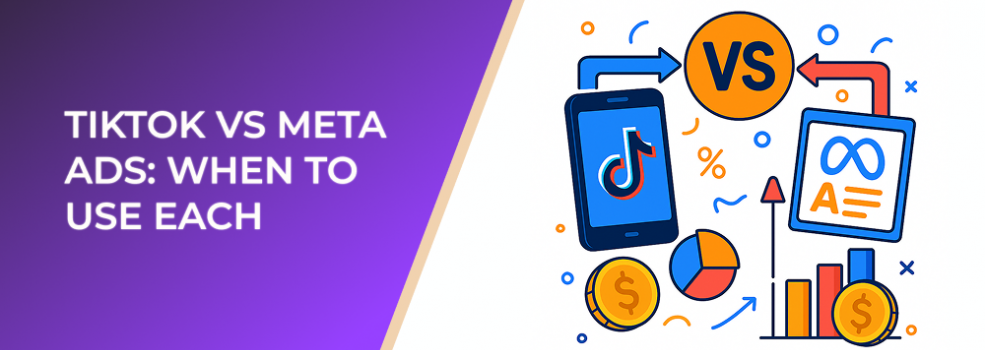Selecting between TikTok Ads and Meta Ads has become one of the most important decisions in digital advertising. Both platforms offer powerful targeting capabilities, large user bases, and scalable ad formats. Yet they behave very differently — from audience intent to creative performance to cost efficiency.
This article breaks down the strengths of each platform, the situations in which they shine, and key metrics marketers should consider.
Platform Overview
TikTok Ads
TikTok is a short-form, entertainment-first platform with a highly engaged user base. More than 50% of users participate in content creation trends, making native-style ads particularly effective. The average session duration often exceeds 10 minutes, demonstrating strong attention levels.
Meta Ads
Meta’s ecosystem includes Facebook and Instagram, both of which offer mature targeting systems grounded in long-term behavioral, demographic and interest-based signals. Facebook alone reaches over 2 billion monthly active users, making it a staple for scalable performance marketing.
Strengths of TikTok Ads
1. High Engagement and Viral Potential
TikTok has one of the highest engagement rates among social platforms. A recent study found that TikTok ads can deliver up to 43% higher engagement compared to other social media ads when the creative is native to the platform.
2. Cost Efficiency for Creative-First Campaigns
TikTok often offers lower CPMs. On average, CPMs are 20–30% lower than on Meta, making it a strong choice for brands that rely on storytelling and experimental visuals.
3. Younger Audience Reach
Around 60% of TikTok users are Gen Z, making it ideal for brands targeting younger demographics, trend-seeking shoppers, or entertainment-driven audiences.
Strengths of Meta Ads
1. Robust Targeting and Optimization
Meta's targeting system remains one of the most sophisticated in digital advertising. Its conversion optimization models are well-suited for campaigns that require precise segmentation or long-term tracking.
2. Higher Purchase Intent
Facebook and Instagram users show stronger purchasing behavior. Meta reports that 76% of its users have made a purchase after seeing an ad, compared to the more discovery-focused behavior on TikTok.
3. Scalable Results for Performance Campaigns
Meta Ads are known for high-return performance campaigns. Industry benchmarks often show 2x higher ROAS for direct response advertisers compared to entertainment-first platforms.
When to Use TikTok Ads
Choose TikTok if:
-
You want lower CPMs for rapid awareness or engagement.
-
Your product appeals to Gen Z or early adopters.
-
Native-style creative fits your brand.
-
You are launching a new product and want rapid reach.
-
You prioritize virality and trend-driven storytelling.
TikTok thrives during the exploration stage of the customer journey. Brands often see dramatic spikes in attention and engagement, especially when creative aligns with trending audio or formats.
When to Use Meta Ads
Choose Meta if:
-
You need consistent conversions and measurable ROAS.
-
Your product targets a wide demographic or older audiences.
-
You rely on detailed audience segmentation.
-
You want stable cost data and predictive performance.
-
Retargeting is a major part of your strategy.
Meta is particularly strong at mid-funnel and bottom-funnel performance. The platform consistently delivers reliable conversion-driven results due to its advanced optimization models.
When to Use Both Platforms Together
Using both systems can increase full-funnel efficiency.
A common winning setup:
-
TikTok for top-of-funnel reach, engagement and viral creative.
-
Meta for retargeting, conversion and repeat purchase campaigns.
Many brands report that running TikTok + Meta together increases total ROAS by 18–25% compared to relying on a single platform.
Conclusion
TikTok and Meta Ads are both powerful tools, but they serve different roles in modern digital marketing. TikTok excels in reach, engagement and creativity-driven campaigns, while Meta remains unmatched in precision, conversion and long-term optimization.
The best approach depends on your goals, audience and creative capacity. For many marketers, the strongest results come from combining the platforms into a cohesive full-funnel strategy.

